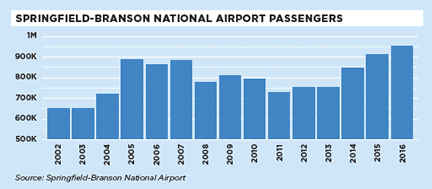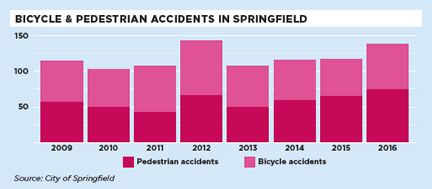TRANSPORTATION

Springfield is keeping up its roadway network and airport, but sidewalk and transit options remain a challenge, despite public-private partnerships.
- Collaborative projects
- Transportation tax approved
- Increased airport traffic
- Growing bicycle and pedestrian network
- Increased transit amenities
- Transportation funding
- Lack of sidewalks
- Increasing congestion
- Transit challenges
- Increasing crashes
Over the years, Springfield's public, private and non-profit organizations have worked together to build a better transportation network. These partnerships have expanded not only the roads, but the bicycle, sidewalk and trail network, airport services and the support of public transit. However, challenges are mounting in terms of meeting the diverse needs of a population that might not have access to a private automobile. In northwest Springfield, the costs of auto ownership exceed 30 percent of household annual income.
BLUE
RIBBONS

In Springfield and Greene County, numerous collaborative projects have leveraged state and federal dollars with local and private investment. Approximately $387 million has been invested through collaboration in the roadway network over the past 30 years.
In 2016, voters approved both the ¼-cent and ⅛-cent transportation sales taxes for the City of Springfield. Improvements will include intersection upgrades, street and bridge widening, signal system and turn-lane updates, alternative transportation projects such as sidewalks and trails, and street resurfacing. Specific projects that will result from these initiatives include additional lanes on Primrose Avenue, Republic Road, and Cherry Street, as well as intersection improvements at Battlefield and Fremont.
 Springfield-Branson National Airport facilities have gone through several major upgrades in the past five years, including expansion of long-term parking at the terminal, a new U.S. Customs Office, and remodeling/expansion of general aviation facilities serving private and corporate aviation. Four airlines serve the airport providing service to 13 direct destinations, up from six destinations in 2000. Airline passenger numbers have grown 30 percent in the last five years, which makes Springfield one of the fastest-growing small hub airports in the country.
Springfield-Branson National Airport facilities have gone through several major upgrades in the past five years, including expansion of long-term parking at the terminal, a new U.S. Customs Office, and remodeling/expansion of general aviation facilities serving private and corporate aviation. Four airlines serve the airport providing service to 13 direct destinations, up from six destinations in 2000. Airline passenger numbers have grown 30 percent in the last five years, which makes Springfield one of the fastest-growing small hub airports in the country.
The trail system for bicycles and pedestrians continues to grow. In 2016, two miles of sidewalks were added in Springfield, bringing the percentage of streets with a sidewalk to 31 percent in the Ozarks Transportation Organization planning area. The city limits of Springfield has 49 miles of signed bicycle lanes, up from 7 miles in 2011.
The City Utilities transit system compares favorably with systems in cities with similar characteristics. The Bus has 12 daytime routes with reduced service on nights and weekends. Nearly 1.5 million rides were provided in 2016. The transit system has improved amenities over the past few years. CU Transit now boasts 100 transit shelters, many with accessible sidewalks. A $6 million transit center opened in spring 2016 with state-of-the-art ticketing and scheduling information.
In the November 2016, the City of Springfield voted to allow transportation network companies to operate within the city limits. The wording was used as a model for the Missouri law that passed in spring 2017 allowing them to operate in Missouri. While official data is not in, there is hope that this service will decrease the number of drivers under the influence of alcohol or drugs.
OzarksCommute.com, launched in early 2017, is an online rideshare matching service that connects commuters who want to share rides to work.
RED
FLAGS

Transportation funding at the state level continues to create issues. The motor fuel and diesel taxes have not increased nor been indexed since 1996. In 2017, public school bus funding was once again cut by state government because of a budget crisis. Public transit funding has decreased significantly in Missouri resulting in minimal operating assistance for public transit.
 Lack of sidewalks continues to be an issue for Springfield, especially in northwest Springfield where pedestrian accidents continue to rise. There continue to be over 100 annual crashes involving bicycles or pedestrians annually within the City of Springfield. Accessibility that complies with the Americans With Disabilities Act is a big concern for those with disabilities, and sidewalks continue to be a pressing need.
Lack of sidewalks continues to be an issue for Springfield, especially in northwest Springfield where pedestrian accidents continue to rise. There continue to be over 100 annual crashes involving bicycles or pedestrians annually within the City of Springfield. Accessibility that complies with the Americans With Disabilities Act is a big concern for those with disabilities, and sidewalks continue to be a pressing need.
As the economy has recovered and unemployment is at record lows, the peak-hour congestion continues to grow. In 2016, 17 percent of measured roadways were congested in the evening, up from 7 percent in 2005. Travel times are increasing during the afternoon rush hour. The north-south corridors in Springfield are continually congested. In addition, we have not been able to identify a funding source to expand Interstate 44, where over 27 percent of the traffic is from large trucks.
Consistent with national trends, transit ridership has declined over the past 12 months largely due to external factors that make driving more affordable, such as low fuel prices and unemployment. Additionally, transit routes were redesigned to improve efficiency and available destinations, resulting in some trips requiring fewer transfers. For residents who continue to rely on transit, lack of density continues to be a challenge for providing higher-frequency transit service at an affordable level. These transit corridors need density of 15 units/acre and clustering of residential, employment, and social-service destinations. Springfield lacks centrally located services and has density of less than 4 units/acre. These challenges, combined with limited funding, hinder the community's ability for transit expansion.
After many years of decline, the number of crashes locally is on the rise, mirroring a national trend. In 2016, crashes in Springfield were up over 6 percent. It is believed that distracted driving and a growing number of vehicles on the road are contributing to this increase. The Missouri legislature has not addressed the need for state legislation prohibiting mobile-phone use while driving.
Community Voices
Students at Missouri State University gathered input from the Springfield citizens via Padlet. Respondents hoped for more public-transportation options to ease traffic congestion.
"We must take a broad view as we grow and expand the transportation system of our community. For many citizens, accessible sidewalks, bicycle friendly streets, trails, and good bus routes are their only modes of transportation. It is our duty to serve the needs of all Springfieldians"
— PHYLLIS FERGUSON
ZONE 1 REPRESENTATIVE,
SPRINGFIELD CITY COUNCIL
For current information on transportation-related issues, visit CARES Engagement Network.

